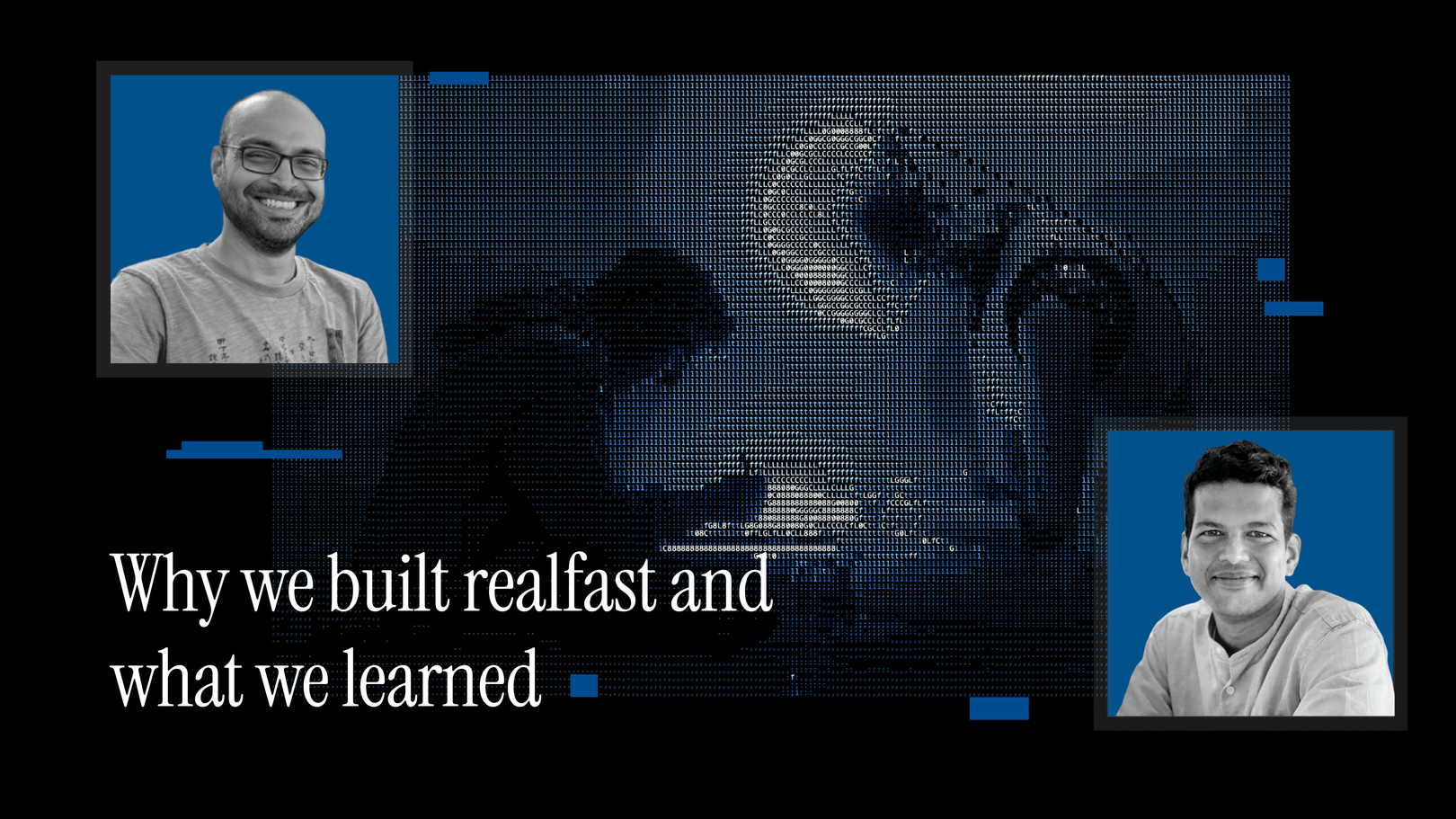Two leaders who helped scale Gojek from 500 to 7 million daily orders share what they’ve learned about building AI that actually works in enterprise environments.
The enterprise AI agent market is about to hit a wall.
While everyone’s building ChatGPT wrappers and promising “AI employees,” the reality is that most of these solutions will fail spectacularly when they encounter the messy, interconnected world of enterprise software. We know this because we’ve been through this transformation before and we’re building something different.
As the co-founders of realfast, we use AI to accelerate Salesforce and Agentforce implementations by up to 20X. We’ve spent the last 18 months watching the enterprise AI space evolve from the inside. Before that, we were part of the team that scaled Gojek from a small Indonesian startup to a decacorn, growing from 500 orders per day to over 7 million. We’ve seen what happens when technology meets real-world complexity at scale.
And here’s what we’ve learned: The problem isn’t that AI isn’t good enough. The problem is that everyone’s solving the wrong problem.
The great AI agent delusion
Walk into any AI conference today, and you’ll hear the same pitch a hundred times: “We’re building AI agents that work like human employees.” The demos are impressive. The valuations are astronomical. The promise is seductive.
But there’s a fundamental flaw in this approach: They’re optimizing for the demo, not the deployment.
Real enterprise work isn’t a series of isolated tasks that can be automated with a clever prompt. It’s a complex web of interconnected systems, tribal knowledge, and edge cases that have accumulated over decades. When your AI agent encounters a Salesforce org with 15 years of customizations, 47 different integrations, and business logic that exists only in the institutional memory of a developer who left three years ago, your beautiful demo falls apart.
This is what we call the “last mile problem” in enterprise AI. The last 10% of the work, the part that deals with real-world complexity, is where 90% of AI projects fail.
Why context is everything (and why everyone gets it wrong)
The current approach to enterprise AI is fundamentally backwards. Most companies are trying to build general-purpose AI agents that can handle any task in any industry. It’s the same mistake that plagued enterprise software for decades, the belief that one size fits all.
But here’s what we learned from our time at Gojek: Vertical-specific solutions always win over horizontal ones when the stakes are high.
When we were scaling Gojek, we didn’t build a generic logistics platform. We built a platform specifically for SE Asian markets, with all their unique challenges around traffic, regulations, and payment systems. The specificity wasn’t a limitation, it was our competitive advantage.
The same principle applies to AI agents.
The most successful AI agents won’t be the most general ones. They’ll be the ones that understand the specific context of their domain better than anyone else.
For Salesforce implementations, this means understanding not just how Salesforce works, but how it works in practice. It means knowing that when a client says they want to “streamline their sales process,” they’re usually talking about a complex web of approval workflows, territory management rules, and integration points that have evolved organically over years.
The real ROI isn’t where you think it is
Everyone talks about AI replacing human jobs. But the real opportunity isn’t in replacement, it’s in amplification.
In our experience, the highest-value AI applications aren’t the ones that eliminate human workers. They’re the ones that eliminate the work that prevents human workers from doing their best work.
Take unit testing, for example. It’s a critical part of software development that most developers hate doing. It’s tedious, time-consuming, and doesn’t feel creative. But it’s absolutely essential for maintaining code quality and preventing production issues.
Our AI agents can write comprehensive unit tests in minutes, not hours. But more importantly, they write tests that are actually good tests that catch edge cases, follow best practices, and maintain consistency across the codebase. The developer still reviews and approves the tests, but they’re no longer stuck in the tedium of writing them.
The result?
Developers spend more time solving interesting problems and less time on repetitive tasks. Projects ship faster. Code quality improves. Everyone wins.
The industrialization of IT services
What we’re really witnessing is the industrialization of IT services. Just as manufacturing went from craft production to mass production, IT services is evolving from artisanal consulting to industrialized delivery.
But here’s the key insight: Industrialization doesn’t mean dehumanization. It means systematization.
The most successful IT services companies of the next decade won’t be the ones that replace their people with AI. They’ll be the ones that use AI to systematize their processes, reduce variability, and scale their expertise.
This is already happening in pockets. Companies that embrace AI-assisted development are seeing 2-3x improvements in delivery speed while maintaining or improving quality. They’re able to take on more complex projects, serve more clients, and command higher margins.
But most companies are still stuck in the old model, throwing more people at problems instead of building better systems.
Why timing matters more than technology
The AI agent market is experiencing a classic case of misaligned incentives. Startups are racing to build the most impressive demos, investors are chasing the biggest market opportunity, and enterprises are paralyzed by the gap between promise and reality.
But timing matters more than technology.
The Applied AI companies that win won’t be the ones with the most advanced AI. They’ll be the ones that solve real problems for real customers right now.
We started realfast with a vision of a new breed of IT Services company - fast and reliable. Then ChatGPT launched, and everything changed. Suddenly, we could use AI to deliver speed and quality at a previously unprecedented level.
The key was starting with the problem, not the technology. We knew exactly what pain points Salesforce implementations faced because we’d been solving them manually for years. When AI became good enough to help, we knew exactly where to apply it.
The future of work isn’t replacement, it’s collaboration
The narrative around AI and jobs is fundamentally wrong. The question isn’t whether AI will replace human workers. The question is how AI will change the nature of work itself.
In our experience, the most successful AI implementations create new types of human-AI collaboration. The AI handles the routine, repetitive tasks that humans find tedious. Humans focus on the strategic, creative, and interpersonal aspects that AI can’t replicate.
This isn’t about making humans obsolete. It’s about making humans more human.
The developers who work with our AI agents aren’t becoming less skilled. They’re becoming more strategic. They’re spending more time on architecture, user experience, and business logic. They’re having more conversations with stakeholders and fewer with IDEs.
What this means for founders
If you’re building in the enterprise applied AI space, here’s what matters:
Start with the problem, not the technology. The most successful Applied AI companies aren’t the ones that use the most advanced models. They’re the ones that understand their customers’ problems so deeply that they can build solutions that actually work.
Go deep, not wide. Vertical-specific solutions will always beat horizontal ones when the stakes are high. Choose your domain and understand it better than anyone else.
Build for deployment, not demos. The gap between a working demo and a production system is enormous. Start with the hardest parts of the problem, not the easiest.
Focus on amplification, not replacement. The highest-value AI applications make humans more effective, not obsolete.
What this means for enterprises
If you’re evaluating AI solutions for your business, here’s what to look for:
Domain expertise, not general capability. The AI solution that understands your specific industry, tools, and challenges will always outperform the one that claims to work for everyone.
Proven results, not impressive demos. Ask for case studies, customer references, and concrete metrics. The most impressive demos often produce the least impressive results.
Integration depth, not feature breadth. A solution that integrates deeply with your existing tools and processes will deliver more value than one that tries to replace them.
Human-AI collaboration, not human replacement. The best AI solutions make your existing team more effective, not smaller.
The next decade of enterprise software
We’re at the beginning of a fundamental shift in how enterprise software gets built and deployed. The companies that recognize this shift and adapt accordingly will have an enormous advantage.
The future isn’t about AI replacing humans. It’s about AI and humans working together in ways that were never possible before. It’s about turning art into science, craft into industry, and ideas into execution.
The question isn’t whether this future will arrive. The question is whether you’ll be ready for it.

